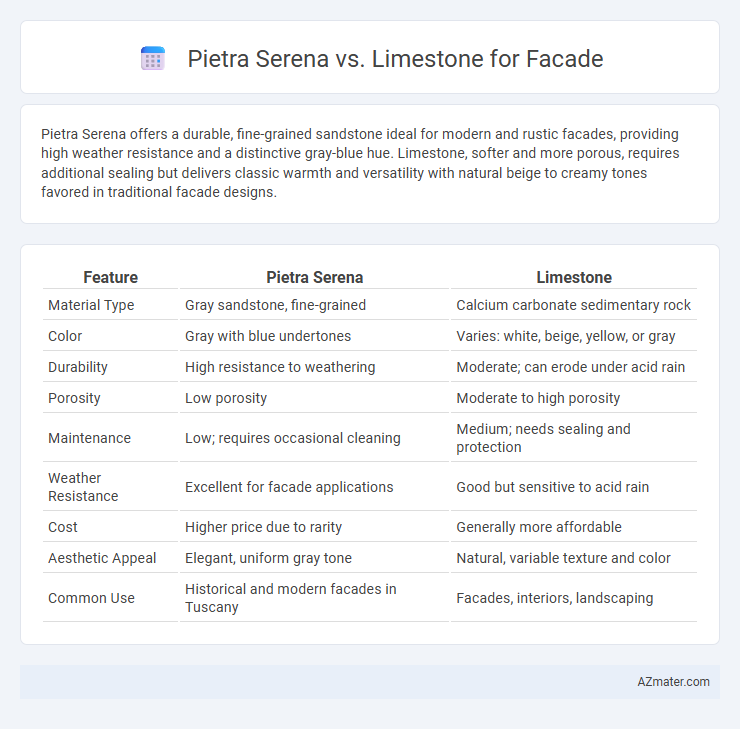Pietra Serena offers a durable, fine-grained sandstone ideal for modern and rustic facades, providing high weather resistance and a distinctive gray-blue hue. Limestone, softer and more porous, requires additional sealing but delivers classic warmth and versatility with natural beige to creamy tones favored in traditional facade designs.
Table of Comparison
| Feature | Pietra Serena | Limestone |
|---|---|---|
| Material Type | Gray sandstone, fine-grained | Calcium carbonate sedimentary rock |
| Color | Gray with blue undertones | Varies: white, beige, yellow, or gray |
| Durability | High resistance to weathering | Moderate; can erode under acid rain |
| Porosity | Low porosity | Moderate to high porosity |
| Maintenance | Low; requires occasional cleaning | Medium; needs sealing and protection |
| Weather Resistance | Excellent for facade applications | Good but sensitive to acid rain |
| Cost | Higher price due to rarity | Generally more affordable |
| Aesthetic Appeal | Elegant, uniform gray tone | Natural, variable texture and color |
| Common Use | Historical and modern facades in Tuscany | Facades, interiors, landscaping |
Introduction: Pietra Serena vs Limestone for Facade Design
Pietra Serena offers a distinctive gray hue and fine grain, making it ideal for modern facade designs emphasizing sleek, contemporary aesthetics. Limestone, known for its warmer tones and natural variations, provides a classic look that enhances traditional and rustic architectural styles. Both materials boast durability and weather resistance, but the choice depends on the desired visual impact and regional availability.
Geological Origins and Composition
Pietra Serena is a fine-grained sandstone primarily composed of quartz and feldspar, originating from the sedimentary deposits in the Tuscany region of Italy. Limestone, formed mainly of calcium carbonate from marine organisms, develops through precipitation or accumulation in shallow, warm marine environments. The geological origins of Pietra Serena result in a denser, more durable material with a matte gray finish, while limestone tends to be softer and more porous, often exhibiting a lighter color palette.
Aesthetic Differences: Color, Texture, and Finish
Pietra Serena exhibits a distinctive bluish-gray hue with a fine-grained, uniform texture that imparts a sleek, modern look to facades, while limestone offers a warmer, cream to beige palette with more variability in grain and fossil inclusions, adding natural character and depth. Pietra Serena's matte finish enhances its sophisticated, minimalist appeal, contrasting with limestone's ability to take on a polished or honed finish that highlights its porous, earthy surface. The subtle color shift and smoother texture of Pietra Serena suit contemporary designs, whereas limestone's organic patterns and warmer tones complement traditional and rustic architectural styles.
Durability and Weather Resistance
Pietra Serena offers superior durability and weather resistance compared to typical limestone, making it ideal for exterior facades in variable climates. Its dense, fine-grained structure resists erosion, moisture absorption, and freeze-thaw cycles better than standard limestone varieties. This enhanced durability ensures long-term aesthetic appeal and structural integrity for building facades exposed to harsh environmental conditions.
Maintenance and Long-Term Performance
Pietra Serena offers superior durability and low maintenance for facades due to its dense, fine-grained structure, resisting weathering and staining better than typical limestone. Limestone, while aesthetically versatile, is more porous and prone to erosion and discoloration, often requiring regular sealing and cleaning to preserve its appearance. Long-term performance of Pietra Serena exhibits greater resilience in urban environments with minimal upkeep, making it a cost-effective choice for facade applications compared to limestone.
Cost Comparison and Budget Considerations
Pietra Serena, a durable and dense sandstone, typically commands a higher price than limestone due to its unique aesthetic and superior weather resistance, impacting overall project budgets. Limestone offers a more cost-effective alternative with easier sourcing and installation, but it may incur additional maintenance costs over time because of its softer composition and susceptibility to erosion. Budget considerations should include initial material costs, long-term durability, and maintenance expenses to determine the most economical choice for facade applications.
Sustainability and Environmental Impact
Pietra Serena offers superior sustainability compared to traditional limestone due to its durability and lower extraction impact, reducing the need for frequent replacement and minimizing waste. Limestone quarrying often involves extensive habitat disruption and higher carbon emissions, whereas Pietra Serena's regional sourcing and longer lifespan contribute to a lower environmental footprint. Choosing Pietra Serena for facades supports eco-friendly architecture by combining aesthetic appeal with enhanced resource efficiency and reduced energy consumption during production.
Architectural Applications and Design Flexibility
Pietra Serena offers superior design flexibility for facades due to its fine-grained texture and consistent gray hues, enabling intricate detailing and modern architectural expressions. Limestone provides a broader palette of colors and natural weathering patterns, ideal for classical and traditional facade designs that emphasize historic authenticity. Architects often choose Pietra Serena for sleek, contemporary aesthetics, while limestone suits projects requiring timeless elegance and sculptural versatility.
Installation Process and Technical Challenges
Pietra Serena requires skilled masonry due to its dense, volcanic origin that demands precise cutting and anchoring techniques for facade installation. Limestone, being softer and more porous, poses challenges in weather resistance and necessitates thorough sealing and reinforcement to prevent erosion and structural instability. Both materials require tailored installation strategies to address their unique physical properties and ensure long-term durability in exterior applications.
Choosing the Right Stone for Your Facade
Pietra Serena offers a distinct gray-blue tone with a fine-grained texture, making it ideal for modern facades that demand elegance and durability. Limestone provides a softer, warmer appearance with excellent weather resistance, suitable for traditional and rustic architectural styles. When choosing between Pietra Serena and Limestone for your facade, consider climate exposure, desired aesthetic, and maintenance requirements to ensure long-lasting beauty and functionality.

Infographic: Pietra Serena vs Limestone for Facade
 azmater.com
azmater.com